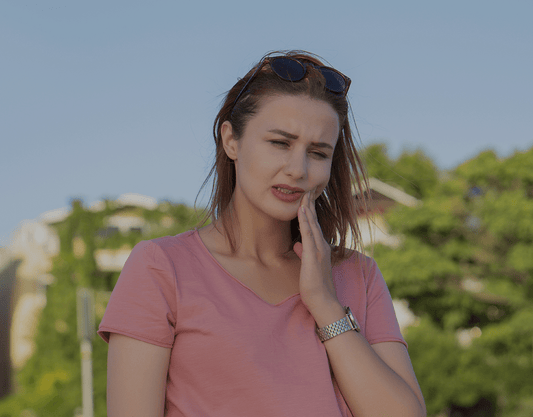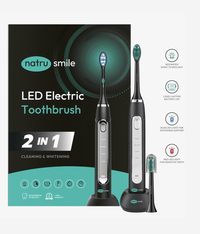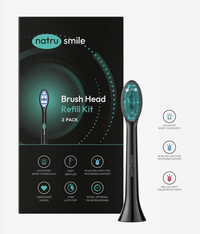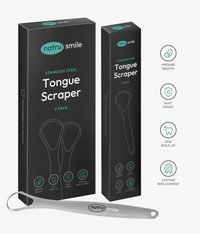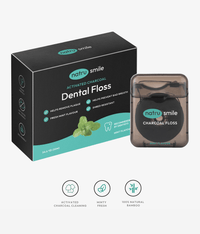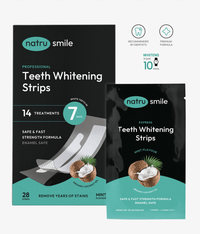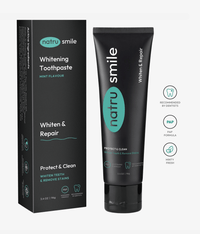
All products are certified by dental expert Dr. Greg Grillo
When you're feeling a little insecure about the coffee stains on your teeth, getting them whitened can be a great way to boost your confidence. It's an instant pick-me-up that can make you feel a million bucks. Sometimes, however, teeth whitening treatments can have an unexpected side effect: burned gums.
This uncomfortable condition is caused by the ingredients in some of the harsher bleaching solutions used by professional dentists or at-home kits and can leave your gums feeling tender and raw. Fortunately, there are many simple treatments available to help you get back on track with your oral health routine.
What Causes Gum Irritation During Whitening?
In order to know how to treat burned gums from teeth whitening, it's helpful to gain an understanding of what causes this condition in the first place. During a professional teeth whitening procedure, your dentist will typically apply either a peroxide-based bleaching solution or an abrasive material (similar to toothpaste) directly onto your teeth and gums. This can cause irritation if you have sensitive skin and are not careful when applying the products. At-home whitening kits may also contain ingredients that are too harsh for some people’s mouths, leading to gum burning as well.
What Are The Symptoms Of Burned Gums?
Burned gums can range from mild to severe, depending on the strength of the bleaching solution used and how long it was left on. Generally speaking, you may experience some or all of the following symptoms:
- Redness or discoloration of the gums. Your gums may turn pink, red, or even purple in color, which is immediately apparent when you lift up your lips.
- Swelling and tenderness. Your gums may be noticeably swollen, puffy, or even feel sore to the touch. You may also notice some pain when brushing or flossing your teeth.
- Slight bleeding when you brush and floss. This is a sign that your gums have been irritated by the whitening treatment and that you need to take extra precautions when cleaning them in order to avoid further damage.
The discomfort of gum burn is highly unpleasant; it can make brushing and flossing a difficult task and can even leave your teeth more vulnerable to plaque buildup. Fortunately, there are many tips you can use to relieve the pain and help restore your gums back to health.
How To Prevent And Protect Burned Gums From Teeth Whitening
Are you suffering from burned gums due to teeth whitening? Here are some of the best ways to prevent and protect them from further damage.
Use A Custom-Fitted Tray
If you’re using an at-home teeth whitening kit, one of the best ways to protect your gums is by getting a custom-fitted tray from your dentist. Many kits – particularly the inexpensive ones – don’t come with a tray that fits your teeth perfectly. The slight gaps can allow the bleaching solution to seep into your gums, leading to gum burn. A custom-fitted tray ensures that the gel stays on your teeth and not your gums.
Trim Whitening Strips
Whitening strips are one of the most popular methods of teeth whitening, but they can also be one of the most damaging if you’re not careful. Many people don’t realize that their gums are more sensitive around the edges – so when you use a whitening strip, it may irritate them. To protect your gums, try trimming the strips to fit your teeth better before applying them. Doing so will help reduce irritation and burning in those areas.
Consider Using A Desensitizing Gel
If you have burned gums from whitening, a desensitizing gel may just be the perfect solution. This gel is typically applied to the gums before or after whitening and helps reduce pain and inflammation. It can also help protect your gums from further irritation for the remainder of your teeth whitening duration.
Get Rid Of Excess Gel Or Bleach
One of the most crucial teeth whitening safety tips to remember is to get rid of any excess gel or bleach as soon as possible. If you leave it on for too long, it can cause burning and irritation in your gums. The last thing you want is to end up with black gums around your teeth or chemical burns on your gums from whitening – so make sure to wipe off the excess product as soon as you can.
Don’t Leave The Strips On For Too Long
It's tempting to leave whitening strips on for as long as possible; after all, you want to get the best results. But this can be a mistake if your gums are already sensitive from previous treatments. Leaving strips on for too long can lead to more burning and irritation in the area; teeth whitening side effects are significantly worsened the longer you leave the strips on.
Switch To A Sensitivity Toothpaste
Have you ever been handed a toothpaste sample at the dentist? Usually, it's a special kind of toothpaste that’s designed to reduce sensitivity in your teeth. This same type of toothpaste can also be used to help protect your gums from burning during whitening treatments. Sensitivity toothpastes contain ingredients like potassium nitrate and strontium chloride, which helps block the nerve endings in the gums and prevent pain when bleaching products are applied.
Reduce Acidic Food And Drink In Your Diet
Acidic foods and beverages can be damaging to your teeth in general, but they can also cause burning and irritation of your gums if you have sensitive skin. If you’re experiencing gum burn from whitening treatments, reducing the amount of acidic food and drinks – such as citrus fruits or coffee – that you consume may help reduce the pain.
Don't Whiten Every Day
In the same way that you should not exfoliate your skin every day, you should also not be whitening your teeth every day. If you are using a bleaching solution or strips on consecutive days, this can cause serious irritation to your gums and teeth. Make sure to give yourself at least a few days of rest between treatments to avoid any further damage.
Tips for Soothing Irritated Gums
We've now covered the tips for avoiding burned gums from teeth whitening – but what if the damage has already been done? How do you treat the burning and irritation? Let's look at some of the best ways to soothe and protect your gums in this case.
Apply Warm And Cold Compresses
Healthline suggests that a combination of warm and cold compresses can be used to reduce the burning sensation on your gums. Simply soak a cloth in warm water and hold it against your cheek over your gums; keep it there for around five minutes, giving enough time for the heat to penetrate and soothe your skin. After the five minutes, switch to a cold compress. Do this cycle up to three times per day for the best results.
Use Hydrogen Peroxide
While it's true that hydrogen peroxide is an irritant in itself, the strong disinfectant qualities can be useful for protecting your gums from further irritation. A hydrogen peroxide gargle can help to kill germs and prevent gum disease; simply mix equal parts of hydrogen peroxide and water and swish it around your mouth for about 30 seconds. Spit out the mixture afterward, making sure not to swallow any of it.
Salt Water Rinses
Salt is known for its antibacterial and antiseptic properties, as well as its ability to reduce swelling and inflammation. Very Well Health recommends a mixture of 8 ounces of water to 1 teaspoon of salt to 2 teaspoons of baking soda; all you need to do is mix the ingredients together and swish it around your mouth for a few minutes before spitting it out. Salt water rinse can help reduce gum burn from teeth whitening treatments – just make sure not to swallow any of the mixture as it can be harmful in large amounts.
Turmeric Paste
Turmeric is a wonder ingredient; it's been used for centuries due to its anti-inflammatory and antiseptic properties. Topical application of turmeric paste can help reduce the irritation and burning of your gums – simply mix 1 teaspoon of turmeric powder with a few drops of water to form a thick paste. Apply this directly to your gums for about 10 minutes, then rinse off with warm water.
Homemade Dental Spray
To make your own dental spray, simply mix 2 drops of clove oil with 1/2 cup of water; you can also add a few drops of tea tree oil if desired. Clove oil and tea tree oil are both known for their antiseptic and anti-inflammatory qualities. In fact, some studies have found that clove oil is just as effective as benzocaine.
Spraying this mixture directly onto your gums can help reduce burning and irritation and will contribute to the killing of bacteria in the area.
Do All Whitening Methods Cause Gum Damage?
No, not all teeth whitening methods cause gum damage. In fact, some of the most popular teeth whitening treatments available today are designed to be as gentle on your gums as possible – such as professional laser tooth whitening or at-home LED light kits. It's important to research which method is right for you and make sure that it doesn't come with any risks of gum damage before you go ahead with treatment. Here at NatruSmile, we offer a range of teeth whitening solutions that are designed to be as gentle and effective as possible.
Can I Whiten My Teeth If I Have Gum Disease?
If you are already suffering from gum disease such as periodontitis, it is not recommended that you undergo any kind of teeth whitening treatment. This is because the chemicals used in these treatments can further irritate and damage your gums, making your condition worse than before. If you are concerned about discolored teeth due to gum disease, it's best to speak with a dental professional who will be able to advise on the best course of action for you. In the meantime, natural solutions such as brushing with baking soda can help to reduce discoloration.
Why Did My Gums Turn White After Whitening?
If you experience white patches on your gums after a teeth whitening treatment, it's likely due to the bleaching products used in the process. Hydrogen peroxide is very strong and can cause chemical burns on the skin if left on for too long; this is why it's so important to follow all instructions carefully when using any kind of teeth whitening product. If you do notice white patches on your gums, make sure to rinse with plenty of water and apply cold compresses as soon as possible.
How Long Do Gum Burns Last?
The duration of your gum burns depends on the severity of the burn and how quickly you treat it. Medical News Today suggests that first-degree oral burns take about 7-10 days, while second-degree burns – which are more likely to be caused by boiling water – can take up to three weeks to heal. Burns from teeth whitening usually fall under the first-degree category, so you can expect them to heal within the week. If your symptoms persist for longer than this, it's best to speak with a dental professional.
Moving along, let’s delve into what people typically ask about gums and teeth whitening.
Do Gums Grow Back After Teeth Whitening?
The mouth is incredibly resilient and is capable of healing from most dental treatments. If your gums have been damaged due to teeth whitening, the good news is that they will likely grow back completely over time. However, it's important to speak with a dental professional if you are worried about any permanent damage caused by the treatment.
How Long Will My Gums Stay White After Teeth Whitening?
The whiteness of your gums after a teeth whitening treatment will depend on the product used and how long it was left on. Generally speaking, this discoloration should fade away within a few days. However, if you notice any lasting changes to your gum color, it's best to speak with a dental professional who can advise on the best course of action for you.
Can Whitening Strips Turn Your Gums White?
Yes, whitening strips can turn your gums white if left on for too long. Most professional teeth whitening treatments involve the use of a gel that is applied directly to the teeth and then covered with a tray or strip. If this product isn't removed after the recommended time period, it can cause discoloration in the surrounding areas, including your gums. To avoid this problem, always follow all instructions carefully when using any kind of teeth whitening product.
How Can I Whiten My Teeth Without Damaging My Gums?
The best way to whiten your teeth without damaging your gums is through professional laser whitening. This process involves using a light-activated gel that works to break down stains and discoloration on the surface of the tooth while being gentle enough not to cause any damage to the surrounding gum tissue. At NatruSmile, we offer a range of safe and effective laser teeth whitening solutions that are designed with both safety and effectiveness in mind.
How Long Do Chemical Burns On Gums Last?
Chemical burns from teeth whitening usually take around 7-10 days to heal. If your symptoms persist for longer than this, it's best to speak with a dental professional who will be able to advise on the best course of action for you.
Is It Normal For Whitening Gel To Burn Gums?
No, it is not normal for teeth whitening gel to burn your gums. If you experience any pain or burning sensations during a teeth whitening treatment, it's likely that the product has been left on for too long – so make sure to follow all instructions carefully when using any kind of teeth whitening product.
Why Did My Gums Turn White After Using Peroxide?
Peroxide is very strong and can cause chemical burns on the skin if left on for too long. If you do notice white patches on your gums after using peroxide, make sure to rinse with plenty of water and apply cold compresses as soon as possible.
The Bottom Line
Teeth whitening is a great way to boost your confidence, get rid of yellow teeth, and improve your smile. However, it's important to do your research beforehand and follow all instructions carefully when using any kind of teeth whitening product in order to avoid any potential damage to your gums. If you have experienced gum burns from teeth whitening, make sure to rinse with plenty of water and apply cold compresses as soon as possible. Turmeric paste, desensitizing gel, and saltwater rinses are also effective for treating gum burns – but prevention is the best approach!

